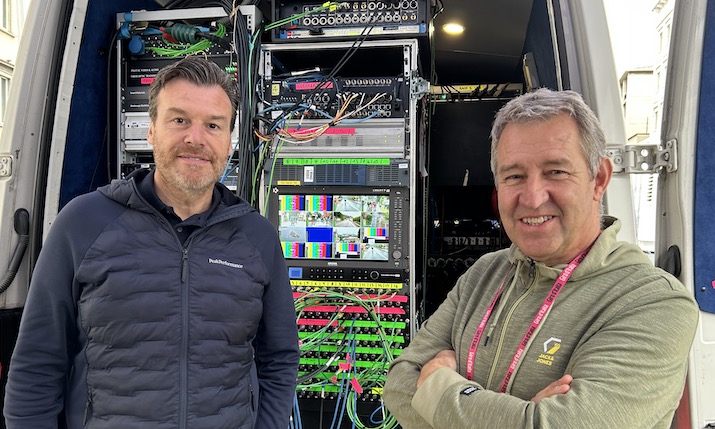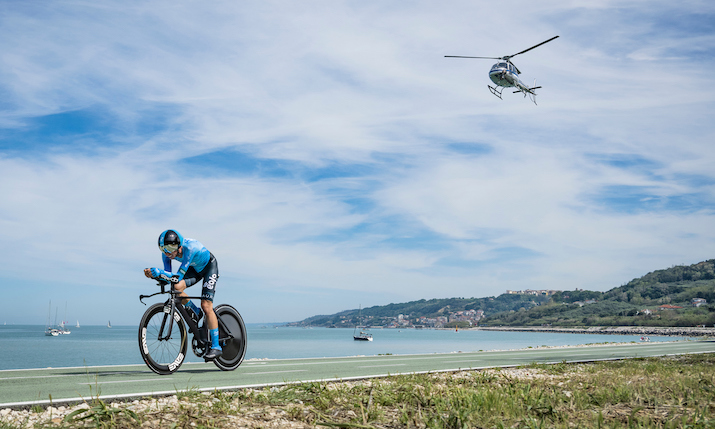Live from Giro d’Italia: EMG’s Gunther Herregodts and Bruno Coudyzer – ‘For us, cycling is religion!’

Bruno Coudyzer and Gunther Herregodts
As EMG Group returns as host broadcaster of the 2023 Giro d’Italia, personnel from EMG Italy, EMG Connectivity and EMG Belgium are leading this impressive production that travels up and down Italy for 29 days, managing connectivity, RF and production.
Bruno Coudyzer, RF division co-ordinator at EMG Connectivity, says: “The main novelty of this year’s production is certainly the presence of a Belgian director. This year, in fact, on board EMG’s Nova 209 mobile control unit is Gunther Herregodts with whom I have worked for many years.
“Gunther is very famous because he specialises in cycling and cyclo-cross, which are very popular sports in Belgium. He is a more ‘technical’ director with whom I have shared many live broadcasts, not only in the classic cycling competitions but also in the Olympics and World Championships.
“This is why he was approached by the UCI because we wanted to improve the editorial side even further and convey all our passion to the spectators.”
Gunther Herregodts, director of the Giro, continues: “This is my first time at the Giro d’Italia, and I was also signed up at the last minute. However, for me it’s a real passion: I’m Belgian and for us, cycling is a religion!
“I didn’t have to make fundamental upheavals to the setup of the cameras compared to the previous edition; in fact, despite the new places on the route, having already worked so much with Bruno has been a great help to me.”
“The setup is slightly more complex here, given the presence of two helicopters for filming (where in Belgium we only use one) and also two radio link aeroplanes, used on the longer routes,” he continues. “There are ten bikes, five of which are in charge of filming and five that are for the commentary.”
One of the new features for this year is an SNG unit in the field that combines uplink and downlink equipment with an editing area in order to enhance efficiency.
Also new to the Giro is a daily highlights edition created for Eurosport which is produced by EMG and which further complicates the already complex TV compound setup.
More on Giro d’Italia:
- Live from Giro d’Italia: RCS Sport’s Andrea Basso on the latest innovations enhancing a complex production
- Live from Giro d’Italia: Inside the travelling TV compound that needs to be ready for anything
- Boost Graphics partners with RCS for timing, live graphics and data processing of the Giro d’Italia 2023
- Grand Tour season spins onto screens as Warner Bros. Discovery presents its global Giro D’italia coverage
RF technology
“The real technical innovation,” Coudyzer adds, “consists of significant improvements in RF technology, thanks to Livetools, a subsidiary of the EMG group that manufactures proprietary products for exclusive use.
“The final quality of the images has been further improved, thanks to the use of new coding and modulation algorithms, which have been developed and adapted to guarantee a very high quality of service in the shortest routes, but also for long ranges and large surveys.
“All the transmitters and modulators are placed on the motorbikes and, given the difficulties of this edition due to the weather conditions, we have applied other improvements in the modulation – which is unique in the sector – brilliantly overcoming all the challenges due to the different altitudes and the presence of snow on the mountains.
“Furthermore, this year, again due to the negative weather conditions, we are using the intermediate radio link stations more to always guarantee the necessary connection.”

The TV helicopter in action along the Adriatic Coast ©kramon
Normally the director at each stage places four cameras before the finish line along with two high speed plus one in RF, which usually takes care of the winner. Two cameras for the podium and a micro camera for the photo finish are also used. In total 12 fixed cameras are on the ground to capture the arrival.
In time trials, three or four more cameras are used at the start and two at the intermediate points. A drone is also necessary in some stages and situations, given the challenges of the route which prevents the placement of fixed cameras and creates difficulty connecting to the satellite.
“It’s a wonderful ride that goes from the sea to the mountains,” concludes Herregodts. “It’s a month of tests that constitute an important challenge for the whole EMG technique, where we use the best technology in HD but we are completely ready for UHD, for the best possible quality and coverage.”
